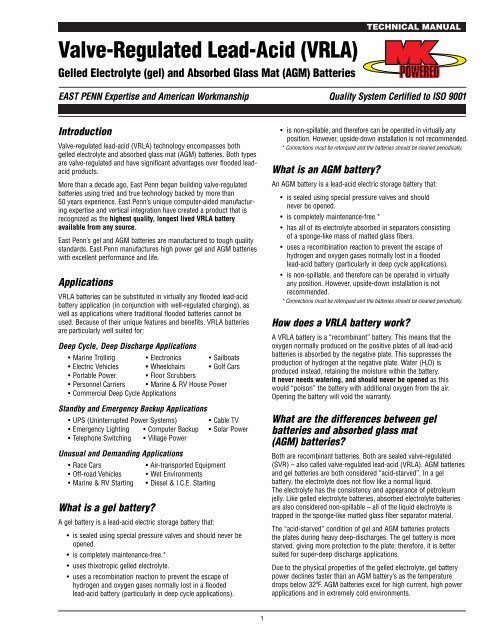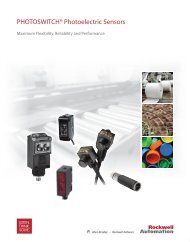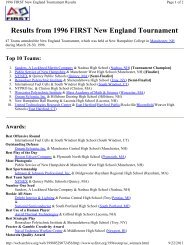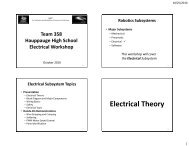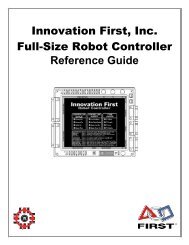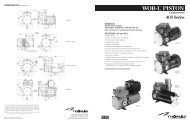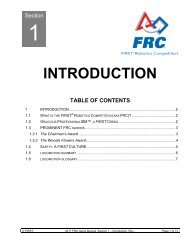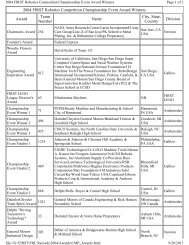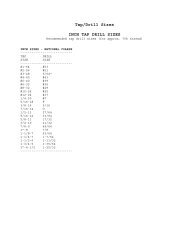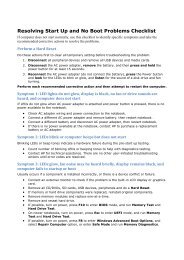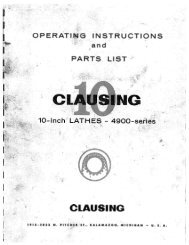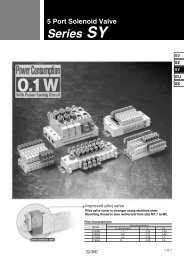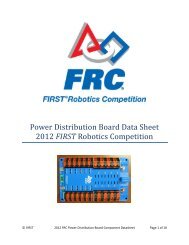(Technical) Manual - MK Battery
(Technical) Manual - MK Battery
(Technical) Manual - MK Battery
- No tags were found...
Create successful ePaper yourself
Turn your PDF publications into a flip-book with our unique Google optimized e-Paper software.
CHART AIndependent Laboratory Testing BCI 2-Hour LifeGroup Size “27” Batteries East Penn Gel and AGM vs. CompetitorThis chart compares the cycles run until the battery capacity dropped to 50% ofthe 15th cycle’s capacity (on discharges at the 2-hour rate to a 10.5-volt cutoff).East Penn AGMEast Penn GelCHART BCharging Current vs.Charging TimeShown is the current needed to charge a battery from 0% to 90% state of chargein a given time. Or time required to change a battery from 0% to 90% stateof charge at a given current. For example, to charge an 8G8D (curve H) to 90% in3.5 hours, 100 amperes are required; at 35 amperes, it would take 10 hoursInitial Charging Current (Amperes)HF, GEDCBAA 8GU1, 8GU1H, 8AU1, 8AU1HB 8G22NF, 8A22NFC 8G24, 8A24D 8G27, 8A27E 8G30H, 8G31, 8G31DT, 8A30H, 8A31, 8A31DTF 8GGC2, 8AGC2G 8G4D, 8A4DH 8G8D, 8A8DHours3
CHART CVRLA <strong>Battery</strong> Voltage During Constant Current DischargeVoltage vs. Percent Discharged% of Cycle Life (B.C.I. RV/Marine) <strong>Battery</strong> VoltageCHART DGel Percent Cycle Life vs. Recharge VoltageThis chart shows the effect on life of overcharging a gel battery.(e.g.: Consistently charging at 0.7 volts above the recommended level reduces life by almost 60%!)Percent DischargedRecharge Voltage (12-volt <strong>Battery</strong>)4
What are the features and benefits thatmake East Penn’s VRLA batteries unique?East Penn ExpertiseEast Penn builds VRLA batteries to the highest standards. Our manufacturingprocess features improved controls using state-of-the artcomputers and the latest manufacturing technology and equipment.Therefore, the VRLA batteries produced by East Penn consistentlymeet the highest quality performance and life standards.Ultrapremium Sealing ValveA critical feature of any VRLA battery, gelled or absorbed, is the qualityof the sealing valve. Not only must the valve keep the cell pressurizedand safely release excessive pressure and gas due to overcharging,but it must also keep the cell from being contaminated by theatmosphere. Oxygen contamination will discharge a VRLA batteryand eventually ruin the battery.Our valves are UL recognized and 100% tested after manufacturing.The benefit is reliable performance and long life.Spillproof and LeakproofA major advantage of VRLA batteries is their spillproof and leakprooffeature. However, all VRLA batteries are not created equal in theirdegree of non-spillability. Some manufacturer’s AGM batteries areunevenly filled. Over-saturation of the separators leaves liquid electrolytethat could spill. Under-saturation could lead to premature failure.Some gels do not set properly; they remain liquid and can leak or spill.Our exclusive gel electrolyte is formulated, mixed and controlled toassure proper “set” in every battery. East Penn’s computer-controlledgel mixing and filling equipment ensures homogenization of the mix.This assures a gel battery that will not spill or leak. This feature allowsour gel cell to be operated in virtually any position. However, we donot recommend an upside-down orientation.The AGM filling process assures that each cell is saturated with themaximum amount of electrolyte that can be held by the separators,without leaving excess electrolyte that could spill or leak.Exclusive Gel FormulaThe gelled electrolyte is another critical element in this type of battery.Our gelled electrolyte contains sulfuric acid, fumed silica, puredemineralized, deionized water, and a phosphoric acid additive.The phosphoric acid is a key reason that our batteries deliverdramatically longer cycle life than leading gel competitors and3 times longer cycle life than traditional wet cells.Exclusive AGM ElectrolyteOur AGM electrolyte contains high purity sulfuric acid and absolutelypure totally demineralized, deionized water to increase batteryperformance. Since the designs are “acid-starved” to protect theplates from deep discharge, the acid concentration can drop to nearlyzero during an extremely deep discharge. Substances that will notdissolve in acid may become soluble when the concentration dropsthis low. Upon recharge, these dissolved substances crystallize outof the electrolyte, potentially destroying the battery. Our electrolyteprevents these events.Exclusive Computerized Gel MixingProper gel mixing is critical to life and performance. Consistency inmixing means consistent reliability. We have designed and built thenewest, state-of-the-art gel battery manufacturing facility in the world.An example is our proprietary computerized gel mixing operation.Our exclusive formula is mixed using computer control in every stageof the process. Computer control delivers superior consistency forgel battery performance that is unequaled.Our temperature-controlled process and specially designed equipmentassure a homogenous gel. It is important to note that ourequipment was designed by our engineers specifically for gel mixing…even down to the contour of the tank bottoms and feed pipe locations.No other battery manufacturer has comparable equipment.Multi-Staged Filling/Vacuuming OperationMost other manufacturers fill their gel cells in a one step process,vibrating the battery with hopes of releasing most of the air pockets.This system is less than perfect and leaves voids or air pockets atthe critical gel-to-plate interface. These voids are non-reactive andreduce overall battery performance.Our process fills and vacuums each cell several times. This multi-stepprocess assures complete evacuation of air and complete gel-toplateinterface. Our computerized process also weighs every batterybefore and after filling as a check for proper gel levels. The benefit ismore power-per-pound of battery.Our AGM topping process assures that the maximum retainable electrolytequantity is held within the battery separators, without leavingany unabsorbed liquid to spill or leak.Tank Formed PlatesEast Penn is the only battery manufacturer that uses tank formationto activate the battery plates. This process guarantees a fully formedand voltage matched plate. The extra handling of the plates providesan additional inspection step in the process to verify plate quality.Ultrapremium, Gel Glass Mat, Double Insulating SeparatorsAnother critical component is the separator, which isolates thepositive from the negative plate. The separator must allowmaximum charge flow between the plates for maximum performance.Separator failure is a leading cause of warranty claimsand customer dissatisfaction.East Penn uses an ultrapremium grade separator in our gel batteries.We believe that this expense (which is 5 to 6 times higher thanother types) is worth the benefits of extended life and performance:• The fiberglass mats embed themselves into the surface ofthe plates, acting like reinforcing rods in concrete. Thisextra reinforcement locks the active material onto the platefor longer life and extended performance.• The ultra-clean separators have no oil contaminationor other impurities. Therefore, resistance is low andbattery performance is high.• Excellent porosity allows maximum charge flow,which means more power-per-pound.• Superior resistance to oxidation dramatically reducesseparator failure, which extends life.• Our separators are especially suited for gel batteries,while others use separators designed for floodedautomotive batteries.5
Ultrapremium AGM glass mat separatorsGlass mat separator properties can vary considerably. East Pennuses glass mat engineered to have an ideal balance of properties—i.e. absorbency, compressibility, puncture resistance and electricalresistance. This attention to detail results in high performance andlong life.Exclusive Thru-Partition Weld SealsOne of the causes of self-discharge in batteries is the minuteelectrical currents that flow between each cell through the partitionat the weld area. These currents accelerate the discharge ofbatteries not in use.We block these currents by using an exclusive weld seal or gasket.This feature dramatically reduces self-discharge to less than 3%per month: the lowest self-discharge rate of any battery manufacturerand seven times lower than many conventional batteries!Exclusive Patented Calcium/Copper Lead Alloy GridsThis exclusive alloy provides longer shelf life, more powerper-poundand superior corrosion resistance. By using specialgrain refiners, we can dramatically improve performance and life.Heavy-Duty Motive Power Style Grid DesignWhile other manufacturers cut costs by using automotive stylegrids, we use a high-performance deep cycle grid. This heavy-dutygrid design is similar to the grid in a motive power battery.The hefty “power rods” designed into our grids not only lock theactive material onto the grid, but also act as “bus bars” to collectand direct the energy to the terminals. The benefit is more powerper-poundof battery for your equipment and longer battery life.Multiple Plate Lug MillingShiny, well milled plate lugs are critical to our superior cast-on-strapquality. Each of our plate lugs is automatically milled to assurethe highest quality strap with no loose or dropped plates. Ourlugs are then fluxed and tinned automatically for an additionalassurance of quality.Heavier Plate StrapsWe use an exclusive lead/tin alloy in a unique multi-stage caston-strapoperation. The result is heavier straps with outstandinglug-to-strap knit. This eliminates dropped and loose plates,thereby improving performance and life.Polyester Element WrapAnother cause of deep-cycle battery failure is “mossing.”This phenomenon occurs late in a battery’s life, as the positiveactive material actually grows around the edge of the separatorand eventually “shorts” against the negative plate. This ends thebattery’s service life.Our AGM separators wrap around the bottom of the plate andare wider than the plates. This makes mossing failures unlikely.To prevent life-shortening mossing in our gel batteries, we use aspecial polyester fiber sheet that is wrapped around the edge ofeach element, similar to the wrap in an industrial battery. Theresult is longer service life.loss is harmful to the battery and is evident by black posts, whichare caused by sulfuric acid fumes escaping from the battery throughand around the lead posts and bushings. These fumes can causecorrosion and can damage sensitive electronic equipment.These pores and fissures are caused by the industry’s method ofcasting posts and bushings. This method produces tiny air pocketsand paths which allow corrosive gas to escape, causing life shorteningdepressurization, cell dry-out and corrosion damage.To eliminate this problem, we use forged terminal posts andbushings, which are completely solid with absolutely no porosity.The benefit is longer life, better performance and no leakage ofcorrosive gas…especially important when installed in or nearsensitive electronic equipment.Acid Stratification PreventionAcid stratification can occur in conventional wet cells. Duringcharge, acid is released at the plate surfaces. During discharge,acid is consumed at the plate surfaces. Since the concentration isnot uniform, diffusion (spontaneous mixing by random molecularmotions) begins. If this mixing occurred rapidly, stratification wouldnot occur, but it is relatively slow, allowing lighter parts of electrolyteto “float” toward the surface and heavier parts to “sink”toward the bottom.The top portion of the plates do not perform as well in contact withlower concentration electrolyte. The bottom portion of the plates donot perform as well with the higher concentration, and will corrodeprematurely. High voltage “equalization” charging is sometimesused in wet batteries to make gas bubbles that re-mix the electrolyte.Because the immobilized gel will not “float” or “sink” within itselfwhen a non-uniform concentration exists, it cannot stratify.Therefore, no high-voltage equalizing charge is necessary. Simplyrecharge at the standard 13.8 to 14.1 voltage setting. This meanslonger life and consistent performance in stationary and standbyapplications.Electrolyte in an AGM battery is strongly held by the capillaryforces between the glass mat fibers, but not completelyimmobilized. Stratification is possible in extremely tall cells, butcannot occur in batteries of the size covered in this document.Convenient Carrying HandlesCarrying handles are included on the (gel) 8GU1H, 8G24, 8G27,8G30H, 8G31DT, 8G31, 8G4D and 8G8D models. Handles are alsoavailable on (AGM) 8AU1H, 8A24, 8A27, 8A31DT, 8A4D and 8A8D.This feature makes carrying, installation and removal easier,more convenient and less time consuming.Dozens of Terminal Options AvailableOur batteries are delivered with the most popular type of terminal;however, on a special order basis many terminal options areavailable. This gives you total flexibility to specify the properterminal for your application… without making compromises.Exclusive Forged Posts and Bushings“Black” posts and oxygen-contaminated batteries are often due toporous lead terminal posts. A battery can lose its critical pressurethrough tiny pores and fissures in the battery terminals. Pressure6
Proprietary Case, Cover, and Pressure VentWe design and mold our own rugged polypropylene cases, ventsand covers in our on-site, state-of the-art plastics molding facility.This provides ultimate control of our high performance designs,quality and delivery to our manufacturing plant, assuring you thehighest quality battery and most reliable service.Environment and Worker ProtectionIt’s nice to know that every possible safeguard was designed intoour process to protect our co-workers and the environment…special safeguards that are exclusive to East Penn. One benefitis assurance of a consistent source for batteries without fear ofgovernmental interference or delays.State-of-the-Art TechnologyWithin our newly constructed multi-million dollar VRLA productionfacility, we have incorporated state-of-the-art manufacturingprocesses that are unmatched by any other battery manufacturer.This major addition allows us to build the most modern andreliable VRLA batteries in the industry.The designs of East Penn's VRLA batteries are always improving.The preceding sections accurately describe East Penn's VRLAproducts as of the date of publication. East Penn reserves theright to change their processes to improve quality, value or utilizeadvances in manufacturing technology. Ratings and capacities maychange without notice.Over 250 Quality Assurance ChecksHundreds of quality checks are performed to assure totalconfidence in the performance and life of our batteries.For example:• 100% Cycling. After initial charging, every batteryis discharged and then recharged at the factory. Thisallows us to check the performance of the battery and giveit a second charge that equalizes the cells for improvedperformance and longer life.It’s interesting to note that, as a cost-saving measure, we usethe current generated during the initial discharge to rechargeother batteries in this computer-controlled process.• Extended Shelf Stand Test. Before shipment, everybattery is required to stand for a designated period of time.Beginning and ending voltages are compared. This extraquality assurance step verifies that the critical pressurecontrol valves are functioning properly.• Filling Weight Control. During this computerized process,batteries are weighed before and after filling. This assuresthat the exact amount of electrolyte is in each battery.• Multi-Staged Filling and Vacuuming Process.Every battery is filled and vacuumed several times duringthis computerized process. Multi-staged vacuumingassures complete electrolyte-to-plate interface, with nopower-robbing air pockets.• Computerized Polarity Check. Every battery is checked bycomputer for proper polarity.• High Rate Discharge Test. Every battery is discharged atapproximately twice the rated capacity. A sensitive computermonitors the voltage drop during this discharge to assure thatevery battery performs as designed.• Formed Element Inspection. Elements are assembled andcharged outside the battery container in a computerizedforming and drying process. This allows visual inspection ofevery grid, plate, separator, and formed element before beingsealed inside the battery, assuring perfect cell elements withlongest life and highest performance.• Tank Formed Plates. Voltage matched plates are criticalin standby applications. Forming each plate outside thebattery assures the highest quality, best matched platesin the industry, and also allows a visual check before andduring assembly.7
How do East Penn’s VRLA battery featurescompare with other types of batteries?FEATUREEPM GEL OTHER GEL EPM AGM 0THER AGMALL WETCELLS1. EPM Expertise YES NO YES NO EPM ONLY2. Spillproof and Leakproof YES YES YES YES NO3. Sealed Valve-Regulated YES YES YES YES NO4. Ultra-Premium Sealing Valve YES NO YES NO NO5. Exclusive Gel Formula YES NO NO NO NO6. Deep Discharge Protection YES YES YES YES NO7. Exclusive Computerized Gel Mixing YES NO NO NO NO8. Tank Formed Plates YES NO YES NO NO9. Multi-Staged Gel Filling/Vacuuming YES NO NO NO NO10. Ultra-Premium Glass-Mat Dual Insulating Separators YES NO NO NO NO11. Exclusive Thru-Partition Weld Seals YES NO YES NO NO12. Exclusive Patented Calcium/Copper Lead Alloy Grids YES NO YES NO NO13. Heavy-Duty Motive Power Style Grids YES NO YES NO NO14. Grid Lug Milling, Brushing and Fluxing YES ? YES NO EPM ONLY15. Heavy-Duty Special Alloy Plate Straps YES NO YES NO NO16. Special Polyester “Moss Guard” Element Wrap YES NO NO NO NO17. Forged Posts and Bushings YES NO YES NO EPM ONLY18. Acid Stratification Prevention YES YES YES YES NO19. Carrying Handles YES ? YES LIMITED LIMITED20. Dozens of Terminal Options YES ? YES ? EPM ONLY21. Highest Cycle Life YES NO YES NO NO22. Highest Performance YES NO YES NO N.A.23. Shelf Stand Test YES ? YES NO NO24. 250+ Quality Assurance Checks w/ ISO 9001 Certification YES ? YES NO EPM ONLY25. State-of-the-Art Technology & Facility YES NO YES NO EPM ONLY8
Answers to the Most Frequently Asked QuestionsNOTE: Before reviewing this section, be sure you understand the difference between gel, AGM, and flooded batteries.How do we justify the premium price ofVRLA batteries to those unfamiliarwith this type of battery?Simply review the advantages, features and benefits, performance,and impressive life cycle results. Based upon this and the lowestcost-per-month or duty cycle you and/or your customer shouldhave no trouble choosing VRLA batteries.However, please remember that these batteries are not foreveryone or every application. Always be aware of the chargingconsiderations. (See pages 11 & 12.)What are the advantages anddisadvantages of the different typesof battery designs?Gelled Electrolyte Advantages:• Totally maintenance-free• Air transportable• Spillproof/leakproof• No corrosion• Superior deep cycle life• Installs upright or on side (side installation may loseabout 10% capacity)• Very low to no gassing (unless overcharged)• Compatible with sensitive electronic equipment• Superior shelf life• Superior rechargeability(from 0% to 90% in 3 1 ⁄2 hours)• No recharge current limitation @ 13.8 volts• Rugged and vibration-resistant• Very safe at sea with no chlorine gas in bilge(due to sulfuric acid and salt water mixing)• Versatile: Starting, Deep Cycle, Stationary• Operates in wet environments…even under 30 feet of water• Will not freeze to –20°F/–30°C (if fully charged)• Lowest cost-per-month (cost ÷ months of life)• Lowest cost-per-cycle (cost ÷ life cycles)Gelled Electrolyte Disadvantages:• Higher initial cost• Heavier weight• Water cannot be replaced if continually overcharged• Automatic temperature-sensing,voltage-regulated chargers must be used• Charge voltage must be limited to extend life(13.8 to 14.1 volts maximum at 68°F)Absorbed Electrolyte Advantages:• Totally maintenance-free• Air transportable• Spillproof/leakproof• No corrosion• Installs upright or on side• Lower cost than gel cell batteries• Compatible with sensitive electronic equipment• Very low to no gassing (unless overcharged)• Excellent for starting and stationary applications• Superior for shorter duration/higher rate discharges• Superior under extreme cold conditions when fully charged• Superior shelf life• Superior rechargeability(from 0% to 90% in 3 1 ⁄2 hours)• Rugged and vibration-resistant• Very safe at sea with no chlorine gas in bilge(due to sulfuric acid and salt water mixing)• Operates in wet environments…even under 30 feet of waterAbsorbed Electrolyte Disadvantages:• Shorter cycle life than gel in very deep cycle applications• Automatic temperature-sensing,voltage-regulated chargers must be used• Water cannot be replaced if continually overcharged• Charge voltage must be limited(14.4 to 14.6 volts maximum at 68°F)Flooded Electrolyte Advantages:• Lowest initial cost• Higher cranking amps• Water can be added (if accessible)• Excellent for starting applications• Tolerant of improper recharge voltage• Certain designs are good for deep cycle applications• Replacements readily available• Good under extreme cold conditions when fully chargedFlooded Electrolyte Disadvantages:• Spillable• Operates upright only• Shorter shelf life• Fewer shipping options• Cannot be installed near sensitive electronic equipment• Watering may be required (if accessible)9
How can continual underchargingharm a battery?In many respects, undercharging is as harmful as overcharging.Keeping a battery in an undercharged condition allows the positivegrids to corrode and the plates to shed, dramatically shortening life.Also, an undercharged battery must work harder than a fullycharged battery, which contributes to short life as well.An undercharged battery has a greatly reduced capacity. It mayeasily be inadvertently over-discharged and eventually damaged.How can you tell if anVRLA battery is fully charged?By using a voltmeter.Open Circuit Voltage vs. State of Charge Comparison*% Open Circuit VoltageCharge Flooded Gel AGM100 12.60 or higher 12.85 or higher 12.80 or higher75 12.40 12.65 12.6050 12.20 12.35 12.3025 12.00 12.00 12.000 11.80 11.80 11.80NOTE: Divide values in half for 6-volt batteries.* The “true” O.C.V. of a battery can only be determined after the batteryhas been removed from the load (charge or discharge) for 24 hours.How can you tell if a VRLA battery hasbeen damaged by under- or overcharging?The only way is with a load test. Use the sameprocedure you would use with a wet cell battery:a. Recharge if the open circuit voltage is below 75%.b. If adjustable, set the load at 1 ⁄2 the CCA rating orthree times the 20 hour rate.c. Apply the load for 15 seconds. The voltage shouldstabilize above 9.6 volts while on load.d. If below 9.6 volts, recharge and repeat test.e. If below 9.6 volts a second time, replace the battery.What is a float charger?What float voltage is recommended?This type of charger continually delivers a pre-set voltage to thebattery, regardless of charge conditions.These chargers are used in stationary, emergency back-up power,emergency lighting, and other applications.The frequency of discharge and temperature will dictate a moreexact setting. For example, the more frequent the discharge, thehigher the suggested recharge voltage, to a maximum of 2.35 voltsper cell (at 20°C/68°F).Our recommended float voltage is 2.25 to 2.3 volts per cell forgel and absorbed models.What is a thermal runaway?The appropriate charge voltage depends on the battery temperature(see page 11). A warmer battery requires a reduced voltage. If thevoltage is not reduced, current accepted by the battery increases.When the current increases, the heating increases. This can continuein a loop feeding on itself with the battery temperature andcharging current rising to destructive levels.Gel batteries are much less susceptible to thermal runaway thanAGM batteries. Batteries may become more susceptible withincreasing age. Without a recombination reaction, flooded batteriesconvert most excess charging energy to gas, not heat. This makesthem almost immune from the thermal runaway.Thermal runaway can be prevented with:• Temperature compensation monitoring at the battery—notat the charger.• Limiting charging currents to appropriate levels (see page 11).• Allowing for adequate air circulation around the batteries.• Using timers, or Ampere-hour counters.• Using smart chargers that recognize the signature of athermal runaway event which will shut the charger down.How do I know if a charger is“gel friendly” or “AGM friendly”?Unfortunately, many chargers on the market claim to be gel“friendly” or “OK for sealed batteries”, but are not. Someovercharge the batteries, while others may not fully chargethe batteries. Some chargers claim to be “smart”. Some “smart”chargers do a good job, others do not. The best choice of chargeroften depends on the application.Use only “voltage-regulated” or “voltage-limited” chargers.Standard constant current or taper current chargers must not beused. The voltage must fall in the range of the chart on page 11.Almost all applications require temperature sensing and voltagecompensation. Beware, many chargers measure the ambienttemperature which could be significantly different from the battery’sinternal temperature.Low frequency current ripple (to about 333 Hz) can be detrimentalto sealed batteries depending on the application. On applicationswhere the charger is connected continuously to a float voltage,especially where simultaneous charge and discharge may occur,the level of current ripple must be a consideration.If you are not sure if a charger is performing properly, follow thisprocedure:a. Using a fully discharged VRLA battery (OCV about 11.8V)and a digital voltmeter, record the initial open circuitvoltage at the battery terminals.b. Using an automatic charger as described above,set voltage if adjustable (14.1V for gel, 14.4V forAGM models).c. Connect and start charging. Record initial on-chargevoltage and current .d. Each hour or so, check and record the on-charge voltageacross the battery terminals. Except for occasional, brief“blips” or pulses, the voltage should not exceed the voltagelimits noted in “b” above.13
e. At the end of charge (when the current is very low or goesto zero) check and record the voltage. Note that the chargermay have turned off by then.f. The disconnected battery should be at 100% or above after a24 hour rest.During the charging time, the charger should not have exceededthe limit (except for occasional, brief pulses). This indicates thatthe charger is working properly.Keep in mind that the voltage limit is at 68°F/20°C. Charging athigher or lower temperatures will change this limit.A temperature-sensing charger should always be used, asmanual adjustments are never accurate and will damage anyVRLA battery.Do VRLA batteries have a“memory” like ni-cad batteries?One of the major disadvantages of nickel-cadmium (ni-cad)batteries is that after shallow discharge cycles, the unused portionsof the electrodes “remember” the previous cycles and are unableto sustain the required discharge voltage beyond the depth of theprevious cycles. The capacity is lost and can only be restored byslowly discharging completely (generally outside the application),and properly recharging. VRLA batteries do not exhibit this“use it” or “lose it” capacity robbing effect known as memory.What is a safe charge rate or voltagesetting for outdoor applications with widetemperature fluctuations if a temperaturesensingcharger is not available?NONE! As the chart on page 11 (Effect of Temperature onRecharge Voltage) shows, charging voltage varies widely withtemperature. There is no fixed voltage setting or current thatwill work. A temperature-sensing, voltage-regulated chargermust be used. Anything else will damage any battery and causepremature failure!Can a VRLA battery be load tested?Yes. See page 13 (How can you tell if a VRLA battery has beendamaged by under- or overcharging?).Why do some VRLA batteries bulge?Why do some VRLA batteries appear“sucked in”? Are there visual signs of afaulty or plugged pressure relief valve?To prevent the permanent loss of gases so that recombinationhas time to take place, each cell can hold up to about 1.5 psiwithout venting.Batteries with very large cells, such as the 8G4D, 8G8D, 8A4D, 8A8Dand 8GGC2, will bulge somewhat as this normal pressure builds. Thisis especially true in higher temperatures, because the polypropylenecase is pliable. Therefore, a certain amount of bulge is normal.The valves only let gas out, never in. A partial vacuum can formwithin a sealed battery under various circumstances. <strong>Battery</strong> temperatureand ambient pressure play a role, but predominantly therecombination and discharge reactions are responsible. After chargingends, the recombination reaction continues until most of the oxygenin the battery headspace is consumed. The total volume of the batterycomponents decreases slightly during a discharge. Deeply dischargedbatteries often have a “sucked-in” appearance. Batteries with largecells may display this appearance even when fully charged.If a battery bulges severely on charge, this is not normal. It is anindication of a blocked valve or an overcharge situation. Such abattery should be removed from service.A sucked-in appearance can also be normal. A sucked-in batteryshould be charged, but if it remains sucked-in after charging, theappearance can safely be ignored; however, if only a single celldisplays or lacks this appearance a load test would be prudent.How safe are VRLA batteries?Can they explode?VRLA batteries are very safe, unless abused. However, as with anytype battery, certain safety precautions must be taken.ALWAYS WEAR SAFETY GLASSESWHEN WORKING AROUND BATTERIES!!SHIELDEYES.EXPLOSIVEGASES CANCAUSE BLINDNESSOR INJURY.DANGER/POISONNO•SPARKS•FLAMES•SMOKINGSULFURICACIDCAN CAUSEBLINDNESS ORSEVERE BURNS.FLUSH EYESIMMEDIATELYWITH WATER.GETMEDICALHELPFAST.KEEP OUT OF OFTHE REACH OF CHILDREN.DO NOT TIP. KEEP VENT CAPS TIGHT AND LEVEL.DO NOTDOOPENNOT OPENFLUSH COVERBATTERIES.BATTERIES.CALIFORNIA PROPOSITION 65 WARNING: Batteries, battery posts,terminals and related accessories contain lead and lead compoundsand other chemicals known to the state of California to cause cancerand birth defects or other reproductive harm. Wash hands afterhandling.Because VRLA batteries normally emit very little to no hydrogen gas,they are safe near sensitive electronic equipment. They do notcause corrosion of surrounding metals. No hydrogen gas meansno dangerous explosions… UNLESS SEVERELY OVERCHARGED!Do not install any lead-acid battery in a sealed container or enclosure.Hydrogen gas from overcharging must be allowed to escape.DO NOT CHARGE IN EXCESS OF 14.1V @ 68°F - Gel CellsDO NOT CHARGE IN EXCESS OF 14.6V @ 68°F - AbsorbedAlways use a reliable, temperature-sensing, voltage-regulated,automatic charger.Because SVR batteries have immobilized electrolyte, they cannotspill or leak, even if punctured. That is why they are approved for airtransport by the International Commercial Airline Organization (ICAO),International Airline Transport Association (IATA), and Department ofTransportation (DOT) as noted on the label if properly insulated fromshort circuits.14
Also, when protected against short circuits and securely braced/blocked, our VRLA batteries “are not subject to any other requirementsof 49 CFR Parts 171-180…” for shipping.Which way does current flow? On which sideshould a circuit breaker be installed?During discharge, electrons progress through the external circuitfrom the negative post toward the positive post. Inside the battery,positive ions move toward the positive plate by diffusion where theyreact, leaving neutral molecules in solution. The resulting neutralmolecules move back toward the negative plate by diffusion. Thereare also negative ions in the electrolyte offsetting the positive ioncharges. Some travel by diffusion toward both the negative and thepositive plates, where they are consumed. During charge, all of thedirections reverse.Although not physically accurate, when designing circuits or makingcalculations, it is just as valid to consider positive charges movingthrough the whole circuit. Indeed, this is the convention used todefine the direction of current in electronics (known as conventionalcurrent).Proper location of disconnects depends on the application.Vehicles can vary, but in most cases, the negative terminal is treatedas ground. The entire chassis is connected to the negative terminalof the battery. The positive side of the circuit is considered “hot.”Switches/circuit breakers should usually be installed on the hotside of a device. When disconnecting the entire battery from thesystem with a fusible link or circuit breaker, breaking the connectionfrom the negative terminal to the chassis often works best.In multiple battery installation, there could be other considerationssuch as total voltage, multiple voltages, and the effects on otherdevices.What do I need to know aboutinstallation, especially in salt watermarine applications?Wiring and WaterproofingALWAYS WEAR SAFETY GLASSESWHEN WORKING AROUND BATTERIES!a. Cabling of the approved gauge should be tinned copper.If using untinned copper, allow plenty of spray silicone to“wick” along the strands.b. Install heat-shrink tubing with a silicone interior; the siliconeforms an excellent moisture barrier. Cut the tubing longenough to cover the terminal lug and plenty of the insulatedportion of the cable. Slip tubing onto the cable.c. Crimp on the appropriate terminal.d. Position the heat-shrink tubing. Heat and inspect.e. Clean battery terminals and connect. Be sure perfect metalto-metalcontact is made, with no dirt, corrosion, grease orforeign material to interfere with current flow.f. Always attach the cable connected to the solenoid or starterfirst. Attach the ground cable last! Tighten snugly, BUT DONOT OVERTIGHTEN, which will damage the terminals or crackthe battery cover. This will destroy the battery and VOID THEWARRANTY.g. Spray exposed terminals and connectors with several coatsof battery terminal corrosion protection spray. (Mask surroundingareas to protect against overspray.)h. For batteries which may be exposed to very wet environments(e.g. bilge mounted batteries) total encasement of the exposedterminals and connectors is necessary. However, do not blockor cover the vents. Allow ventilation.A battery terminal boot should be used. Install the boot on thecable before crimping the terminal. Fill the boot with petroleumjelly and fit over the sprayed connectors (as in “g” above).i. <strong>Battery</strong> charging in a boat requires a charger specificallydesigned for marine applications. In addition to battery gases,bilges often contain potentially dangerous fuel fumes.Follow all wiring and grounding recommendations of thecharger manufacturer for on-board and on-shore connections.Using a charger not specifically designed for marineapplications or failure to follow the marine chargermanufacturer’s grounding and wiring recommendationscould result in major corrosion damage to the hull orprop, and create a serious risk of electrical shock or fire,personal injury or death.<strong>Battery</strong> InstallationNote: In a multi-battery installation, it is often best to replace theentire set of batteries when one battery is weak or has failed.SeriesA “series” system increases the voltage, but keeps the batterycapacity (cranking amps, amp hours, reserve minutes, andminutes running time) the same. Therefore, two 12-voltbatteries connected in series (POS to NEG, NEG to POS)will deliver 24 volts at the same rating as one battery:During recharge, each battery receives the same amountof current; e.g. if the charger is putting out 10 amps, bothbatteries are getting 10 amps.Series hookupincreases voltage…2 x 12V = 24 VoltsParallelA “parallel” system increases the capacity available, but keepsthe voltage the same. Therefore, two 12-volt batteries with400 CCA, 110 R.C. and 65 Ah will deliver 12 volts, 800 CCA,220 R.C. and 130 Ah. (Actually, since each battery’s load islighter, the reserve capacity will more than double.)Parallel hookupkeeps same voltage…2 x 12V = 12 Volts15
During recharge, the current (amps) is split between thebatteries. The battery that is discharged the most will receivemore current than the other until both are brought up to fullcharge.Series/ParallelA “series/parallel” system provides a combination of voltageand capacity for special applications. Note: Never mix differenttypes and sizes of batteries in the same bank.Dual VoltageThe illustration shows an arrangement that would supply24 volts to a starter and 12 volts to the electronics (or vice versa).To properly recharge, a sophisticated “battery isolator” shouldbe installed. Otherwise, one battery will be continually overchargedand the other undercharged in a dual-voltage set-up.IMPORTANT: Do not install any type of battery in a completelysealed box or enclosure. In the event of overcharging,the potentially explosive gasses must be allowed toescape.12 VOLTS24 VOLTSDual Voltagehookup providesa combinationof voltageand capacity.MEMBER OF:AMERICAN BOAT& YACHT CLUBUL Recognized ComponentINDEPENDENT BATTERYMANUFACTURERSASSOCIATIONNATIONAL MARINEMANUFACTURERSASSOCIATIONDISCLAIMER: By providing this information, East Penn, its employees and distributors make no representation or warranties about the information provided in this document.All content is provided without warranties, express or implied. East Penn and its representatives are not to be held liable for any and all damages whatsoeverin using or interpreting the information in this document, whether suitable or not.<strong>MK</strong> <strong>Battery</strong>1645 South Sinclair Street • Anaheim, California 92806Toll Free: 800-372-9253 • Tel: 714-937-1033 • Fax: 714-937-0818Web: mkbattery.com • Email: sales@mkbattery.comE.P.M. Form No. 0563 Rev. 3/04© 2004 by EPM Printed in U.S.A.No part of this document may be copied or reproduced, electronicallyor mechanically, without written permission from the company.16


